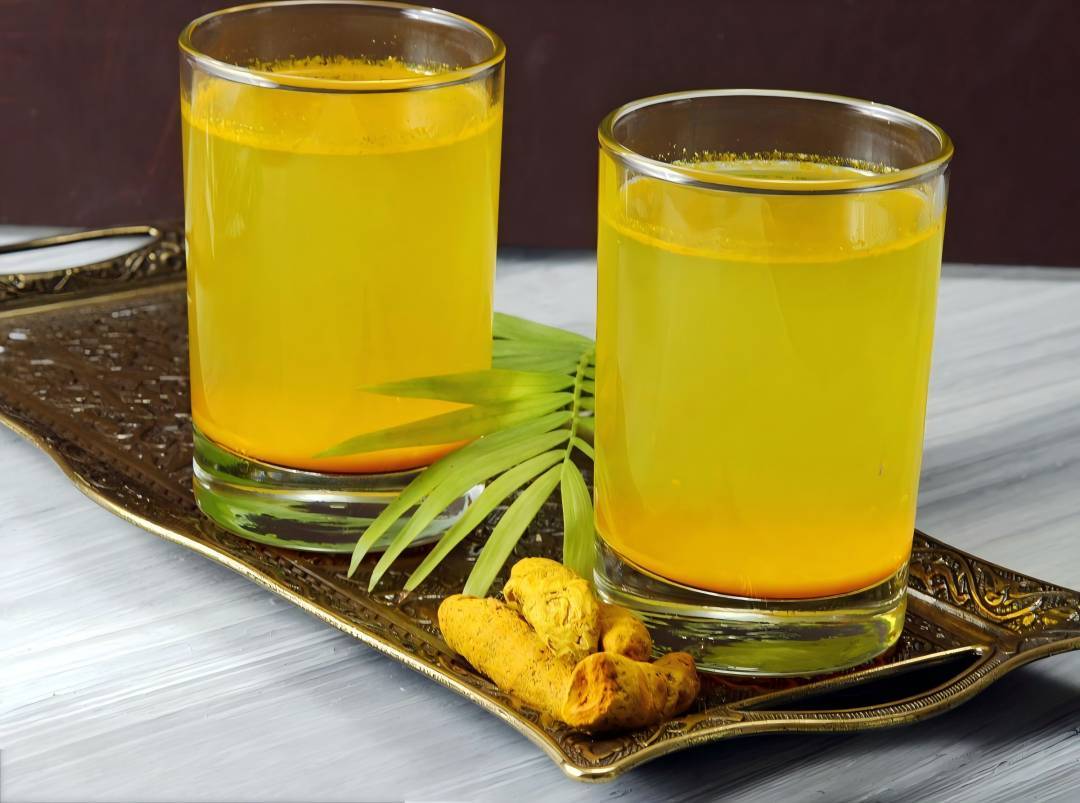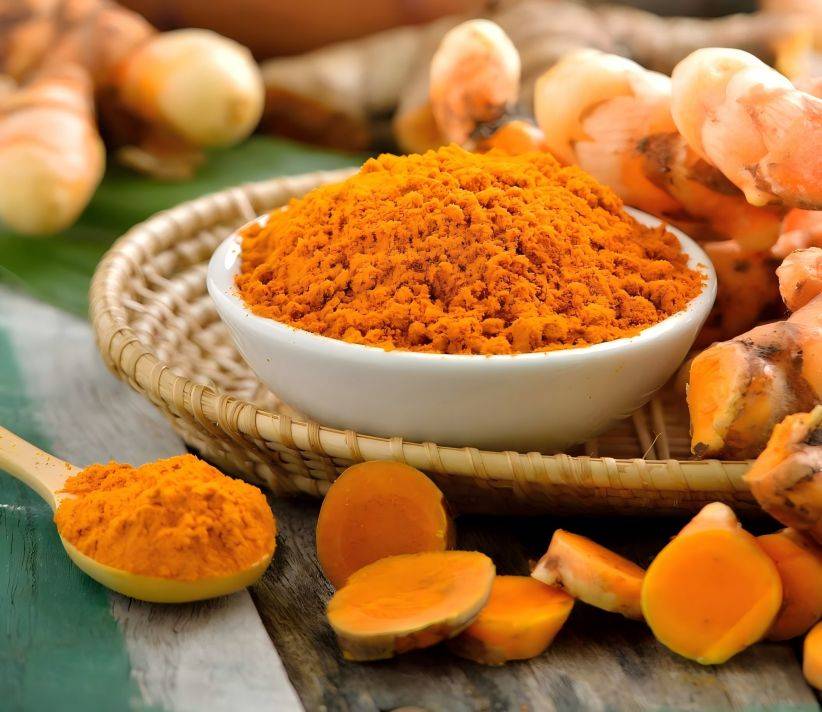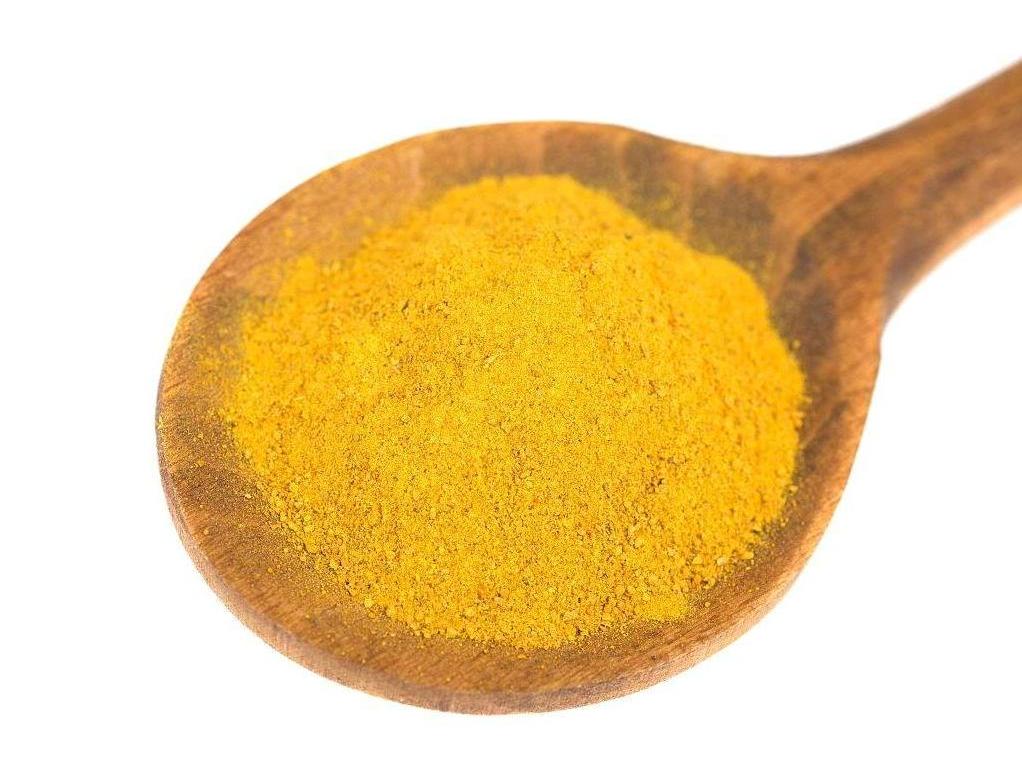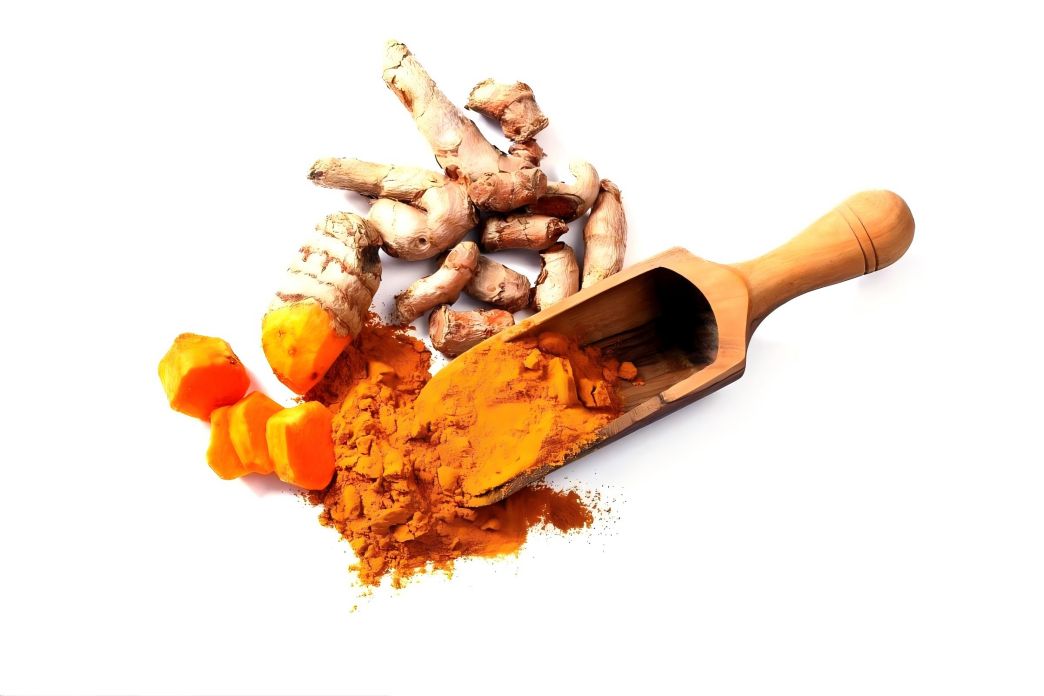What Is Turmeric Extract Curcumin Powder?
Curcumin is currently one of the world's best-selling natural food colors. It has strong coloring ability, good heat stability and coloring properties [1]. Curcumin is mainly derived from the rhizomes of the Curcuma longa plant in the ginger family, and has a long history of use in China for coloring curry powder. Because it is safe, non-toxic and has no side effects, it is considered to be the most valuable natural active ingredient and has been approved as a natural food additive by the World Health Organization/Food and Drug Administration [2]. Turmeric, which is used both as a medicine and a food, has anti-tumor, anti-inflammatory, and blood lipid-regulating effects [3]. Curcumin is easily soluble in organic solvents such as alcohols, acetic acid, acetone, and other organic solvents and alkaline solutions, but not in water. Its chemical molecular formula is C21H20O6, and its main chain is an unsaturated aliphatic and aromatic group [4].
1 Extraction methods for curcumin
The methods for extracting curcumin mainly include organic solvent extraction, alkaline water extraction, enzyme extraction and ultrasonic extraction. Organic solvent extraction mainly involves extracting turmeric with organic solvents such as alcohol and acetone to extract curcumin. This method is simple and the reaction conditions are controllable, but the amount of organic reagent used is large, and a reaction temperature that is too high can destroy the structure of the extract [5]. Sodium hydroxide extraction is low in cost and can obtain curcumin with high purity and dryness, but the reaction is violent and easily destroys the structure of curcumin [6]. The enzyme extraction method mainly uses complex enzymes such as cellulase to destroy the cell walls of turmeric to achieve the effect of extraction. However, this method requires high professional operation and harsh enzyme activity conditions, and is not suitable for large-scale industrial applications [7].
In view of the stability, extraction rate and cost of curcumin extraction, some researchers have explored new extraction techniques for curcumin. Zhao Xi Xi et al. [8] used ultrasonic-internal boiling to assist in the extraction of curcumin. The study showed that this method is stable and feasible, and the optimized extraction process obtained a curcumin extraction rate of 1.139%. Ran Qiliang et al. [9] boiled turmeric in an alkaline solution with a pH of 9.0 to 9.5, and then acidified and separated it to obtain a finished curcumin product with a total content of 5% to 6%. This process is simple, safe, and requires little investment in equipment. PYO et al. [10] used supercritical fluid extraction using ethanol as an entraining agent to extract curcumin from curry powder, with a yield of 24.73 mg/g. This method can maximize the retention of the biological activity of curcumin.
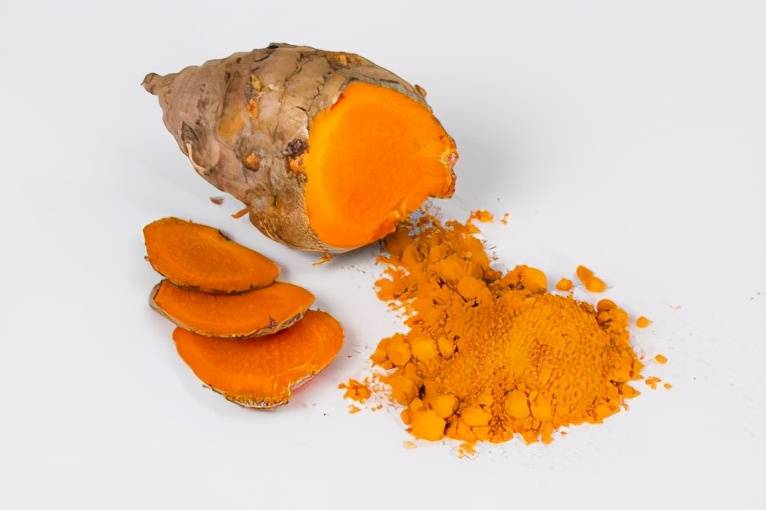
2 The biological activity of curcumin
2.1 Anti-inflammatory and antibacterial effects
The anti-inflammatory effect of curcumin works by inhibiting major inflammatory mediators such as cyclooxygenase (COX-1, COX-2), lipoxygenase (LOX), tumor necrosis factor α (TNF-α), interferon γ (IFN-γ) and transcription factors such as nuclear transcription factor κB (NF-κB) and activator protein-1 (AP-1) [11]. Curcumin can also regulate cell proliferation to affect its immune function [12]. Curcumin can affect the activity of phagocytes and can also inhibit the growth of viruses, bacteria, etc. [13]. Studies have shown that curcumin can inhibit the Human Immunodeficiency Virus (HIV), and curcumin also has a strong inhibitory effect on bacteria such as Trichophyton rubrum and Trichophyton mentagrophytes [14]. The regulatory effect of curcumin on bacteria is also reflected in changes in immune function. Curcumin can inhibit intestinal bacteria, improve immune function, and improve growth performance.
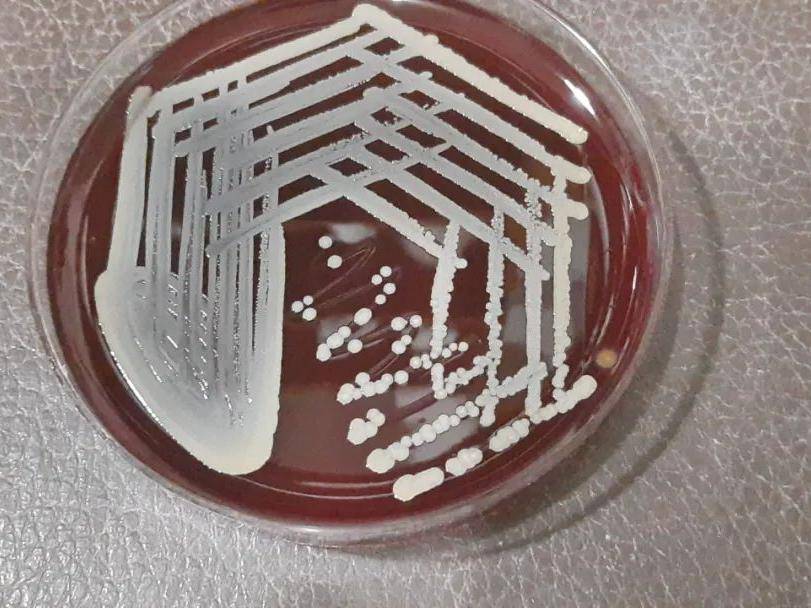
2.2 Antioxidant effect
The antioxidant process of all antioxidants can be roughly divided into two processes: the free radical capture process and the free radical termination process, which can be expressed as follows:
S-00 (or S) + AH → S-OOH (or SH) + A · A · → non-radical substance
where S represents an oxidized substrate, AH represents an antioxidant, and A· represents the radical of the antioxidant [5, 16].
Curcumin has the effect of scavenging active oxygen radicals and resisting lipid peroxidation. Its antioxidant activity is comparable to that of vitamins C and E, and it can protect lipids or hemoglobin from oxidation [16]. Curcumin is thought to play an important role in pathological states mediated by oxidative stress. Curcumin has two phenylpropanoid backbones similar to cinnamaldehyde, with one phenolic hydroxyl group and one methoxy group on each of the two benzene rings, and an alkene group linked to a β-diketone/enol structure. In addition, the antioxidant activity of curcumin is related to its ability to inhibit lipid peroxidation and maintain the activity of various antioxidant enzymes [17].
2.3 Anti-cancer and anti-tumour effects
Curcumin can significantly induce apoptosis in tumor cells, regulate the expression of oncogenes and related proteins, induce cell cycle arrest, block cell signal transduction pathways, inhibit tumor invasion and metastasis, reverse cell drug resistance, and increase chemotherapy sensitivity [18]. Yan Meidi et al. [19] showed that curcumin can significantly inhibit the growth and proliferation of human thyroid cancer SW579 cells and increase the apoptosis rate of thyroid cancer cells. The US National Cancer Institute has included curcumin as a third-generation chemopreventive agent for cancer and listed it in the United States Pharmacopoeia [20]. Liu Bixia et al. [21] established a tumor model and intervened with curcumin. The results showed that curcumin could inhibit the proliferation of H22 liver cancer cells and anti-angiogenesis by regulating the expression level of tumor tissue, thereby inhibiting the tumor. Curcumin can inhibit the proliferation of squamous cell carcinoma cells in the head and neck by mediating the anti-apoptotic inhibitor NF-κB [22].
2.4 Lipid-regulating effect
Curcumin can regulate blood lipids by reducing the levels of triglycerides (TG) and total cholesterol (TC) in the blood plasma and liver. LI et al. [23] showed that curcumin has the same lipid-regulating effect as lovastatin through serum biochemistry and metabolomics analysis. Curcumin can activate protein kinases and peroxidase receptors to regulate liver lipid metabolism, reduce liver steatosis induced by high-fat diet, and thus inhibit fatty liver [24]. Feng Ying et al. [25] showed that high concentrations of curcumin can down-regulate Caspase-1 levels and exert an anti-necrosis effect, thereby delaying atherosclerosis.
3. Application of curcumin in the food industry
3.1. Fresh-keeping
Curcumin is a plant polyphenol with strong antioxidant and preservative properties. Situ Manquan et al. [26] used 0.03% curcumin and 0.06% xanthan gum as a preservative to treat the fruits of Malus water orange. The study found that after 90 days of storage, the rot rate and weight loss rate of the fruits were significantly lower than those of the control. Wang Xiaofu [27] used curcumin at different concentrations to cultivate the fungus Phomopsis stematae and Botrytis cinerea in vitro and in vivo, and inoculated it onto kiwifruit. The results showed that curcumin could significantly inhibit the germination of fungal spores and mycelial growth, and the diameter of the kiwifruit lesions was significantly reduced. In order to enhance the preservative effect of curcumin in food, domestic and foreign scholars have conducted a large number of studies. The studies have shown that substances such as microcapsules, electrospinning, nanocomplexes and colloids containing curcumin can maintain their antibacterial and antioxidant properties and extend the shelf life of food [28].
3.2 Condiments and pigments
Curcumin is a natural pigment that is specified for use in the Food Safety National Standard for Food Additive Use Standards (GB 2760-2014) and is widely used in the food industry. China began researching and applying curcumin in the mid-to-late 1980s, and currently, water-soluble and oil-soluble curcumin products have been developed domestically [29]. Turmeric extract, as a compound condiment, is an indispensable coloring agent in curry food. It is widely used in puffed food, seasonings, rice and flour products, and beverages.
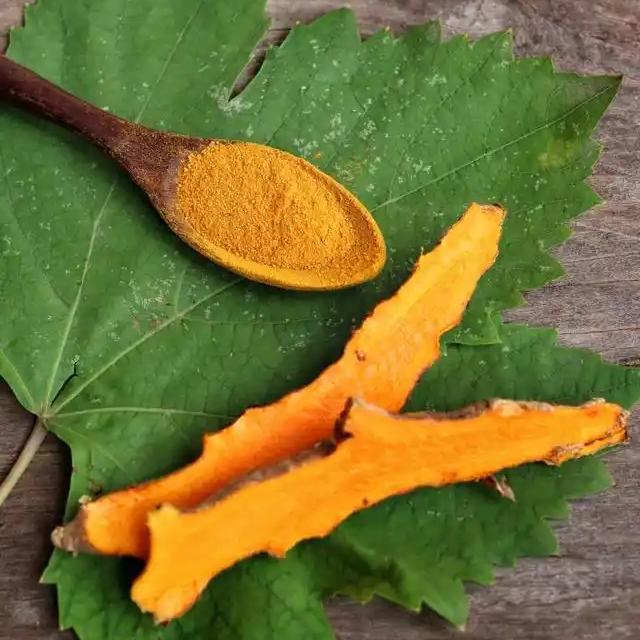
3.3 Other
Huang Yang et al. [30] prepared microcapsules with turmeric extract as the core material and gelatin and egg white powder as the wall material, and studied the effect of the core-to-wall ratio, the emulsifier to core material mass ratio on the entrapment rate of turmeric extract in the microcapsules. The product obtained in the study can protect the functional components of curcumin, prevent oxidation, increase product stability, and has good functionality. Zhang Zhiyun et al. [31] used supercritical CO2 to study the preparation of curcumin hydroxypropyl-β-cyclodextrin inclusion with high solubility, which is about 400 times the solubility of pure curcumin. A study by Gorye et al. [32] showed that octenyl succinate-oat beta-glucan ester (OSG) can form micelles with a shell-core structure and has a good solubilizing effect on liposoluble curcumin. The stability of curcumin solubilized by OSG micelles added to a fruit juice system decreases with increasing heating temperature. The stability is significantly higher when stored refrigerated (4 °C) than when stored at room temperature (25 °C). WENG et al. [33] prepared curcumin-loaded nanoparticles based on paeony protein. The dispersion of the nanoparticles is uniform, and the thermal and photostability is good, with strong antioxidant capacity.
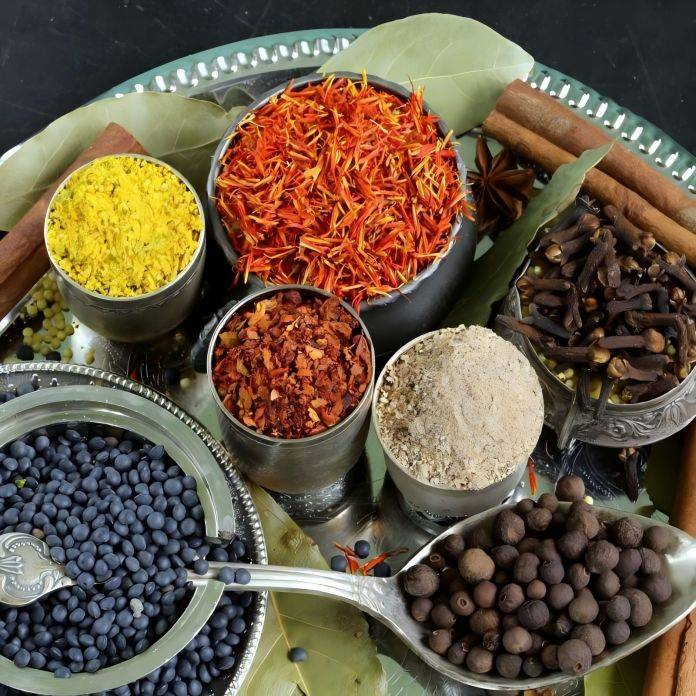
4 Conclusion
Curcumin has a long history of research and is widely used. In recent years, a large number of studies have shown that curcumin has anti-inflammatory and antibacterial, antioxidant, anti-cancer and anti-tumor effects. However, the mechanism of action of curcumin is complex and requires further in-depth research. As a natural coloring agent, it is currently widely recognized in the beverage, pasta, and compound seasoning industries as a flavoring and coloring agent. However, curcumin still has many problems in practical production and application, such as low solubility, low absorption rate, and poor stability, which leads to its low bioavailability and limits its application in health products and the medical field.
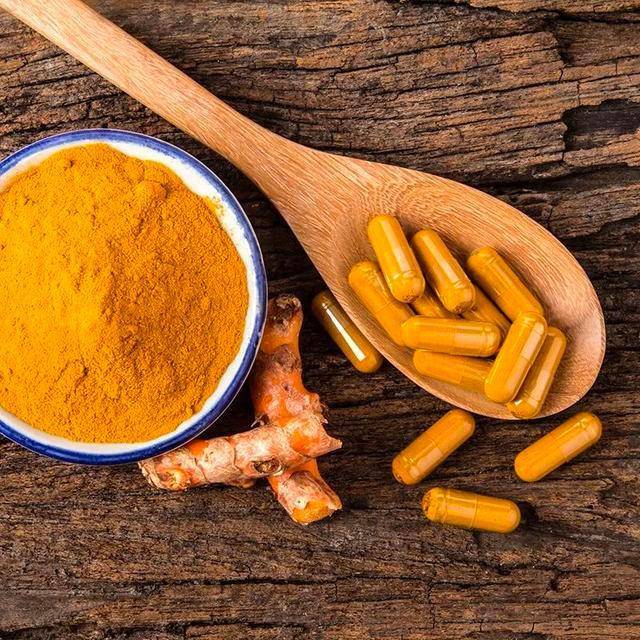
References
[1] Zhou, A. R., Ge, S. H., Kong, Z. H., et al. Functional properties and toxicological research progress of curcumin [J]. Food Research and Development, 2019, 40(16): 219-224.
[2] Zhao Qianqian, Xiao Zhiyong, Zhu Cuiping, et al. Optimization of curcumin extraction process by ultrasonic-internal boiling method using Box-Behnken experimental design [J]. Journal of Liaoning University of Traditional Chinese Medicine, 2021, 23(12): 36-40.
[3] Zhang Yu, Zhang Hongbing, Guo Hong, et al. Research progress of turmeric and predictive analysis of quality markers (Q-Marker) [J]. Chinese Herbal Medicine, 2021, 52(15): 4700-4710.
[4] Huang Rongqing, Xu Chuanjun, Lan Tao, et al. Research progress on curcumin extraction technology [J]. Subtropical Plant Science, 2019, 48(4): 384-390.
[5] Li Ziyi. Extraction and separation of curcumin and its application in cosmetic products [D]. Guangzhou: South China University of Technology, 2018.
[6] Sheng Liuqing, Yan Jizhong, Liang Wanggen. Research progress and application overview of curcumin [J]. Western China Science and Technology, 2006(4):14-15.
[7] Feng Tianhua. Study on purification, stability and antioxidant properties of curcumin [D]. Chongqing: Chongqing University, 2016.
[8] Zhao Qianqian, Xiao Zhiyong, Zhu Cuiping, et al. Optimization of curcumin extraction process by ultrasonic-internal boiling method using Box-Behnken design [J]. Journal of Liaoning University of Traditional Chinese Medicine, 2021, 23(12):36-40.
[9] Ran Qiliang, Zhou Xianrong. Research on a new process for the preparation of curcumin [J]. Food Science, 1988(5):12-15.
[10]PYO D J,KIM E J.Rapid and efficient extraction of curcumins from curry powder using supercritical CO2[J].Bulletin of the Korean Chemical Society,2014,35(10):3107-3110.
[11] Di Jianbin, Gu Zhenlun, Zhao Xiaodong, et al. Research progress on the antioxidant and anti-inflammatory effects of curcumin [J]. Chinese Herbal Medicine, 2010, 41(5): 854-857.
[12] Fan Haoning, Tong Li, Fan Qin. Research progress on the inhibition of tumors and radiosensitization by curcumin [J]. Chinese Journal of Experimental Pharmacology ,2013,19(3): 333-335.
[13] Zhong Yingying , Huang Xiaochang , Chen Shiyi . In vitro antibacterial activity of curcumin [J]. Anhui Agricultural Science ,2010,38(34):19369-19370.
[14] Li, Xiaopeng. Study on the extraction, isolation, antibacterial and antitumor activities of curcumin [D]. Jinan: Shandong Normal University, 2010.
[15] Lu, Xinjun, and Jiang Hetai. Physiological functions of curcumin and its application prospects in the food industry [J]. China Food and Nutrition, 2006(4):31-32.
[16] Sun Linlin, Qiao Li, Tian Zhenhua, et al. Research progress on the chemical composition and pharmacological effects of turmeric [J]. Journal of Shandong University of Traditional Chinese Medicine, 2019, 43(2): 207-212.
[17] Li Jun, Xiong Kun, Gong Yuan, et al. Research progress on the antioxidant mechanism of curcumin based on signal transduction pathways [J]. Chinese Herbal Medicine, 2016, 47(13): 2373-2380.
[18] Dong Wei, Liu Hui. Research progress on new dosage forms of curcumin for anti-tumor [J]. Journal of the Second Military Medical University, 2015, 36(7): 771-775.
[19] Yan Meidi, Cen Xueying. The effect of curcumin on the proliferation and apoptosis of thyroid cancer cells SW579 [J]. Chinese Family Medicine, 2015, 13(3): 396-398.
[20] Zhang Lijuan, Lu Yin. Research progress on the anti-tumor mechanism of curcumin [J]. Chinese Journal of Traditional Chinese Medicine Information ,2008(4):100-102.
[21] Liu Bixia, Zhang Hongyan. Research on the antitumor effect and mechanism of curcumin on H22 liver cancer and S180 sarcoma in mice [J]. Chinese Modern Doctor ,2017,55(9):48-52.
[22]MARIA M,MYSORE S,HELEN L,et al.Curcumin suppresses growth of head and neck squamous cell carcinoma[J]. Clin Cancer Res,2005,11(19):6994-7002.
[23]LI Z Y,DING L L,LI J M,et al.1H-NMR and MS based metabolomics study of the intervention effect of curcumin on hyperlipidemia mice induced by high-fat diet[J].PLoS One,2015,10(3):120950.
[24]UM M Y,HWANG K H,AHN J,et al.Curcumin attenuates diet-induced hepatic steatosis by activating AMP activated protein kinase[J].Basic & Clinical Pharmacology & Toxicology,2013,113(3):152-157.
[25] Feng Ying, Chen Guang, Chen Linjin, et al. Protective effect and mechanism of curcumin on APOE-/- atherosclerotic mice [J]. Chinese Journal of Health Engineering, 2021, 20(6): 921-923.
[26] Situ Manquan. Study and application of the preservative effect of curcumin on postharvest mandarin oranges [D]. Guangzhou: Zhongkai University of Agriculture and Engineering, 2014.
[27] Wang Xiaofu. Study on the antioxidant properties and antibacterial effects of curcumin on kiwifruit pathogens [D]. Hefei: Hefei University of Technology, 2018.
[28] Yuan Peng, Chen Ying, Xiao Fa, et al. Bioactivity of curcumin and its application in food [J]. Food Industry Science and Technology, 2012, 33(14): 371-375.
[29] Huang Hahe, Huang Chongxing, Zhang Linyun, et al. Research progress on the application of curcumin in food preservation [J]. Food Industry Science and Technology, 2020, 41(7): 320-324.
[30] Huang Yang, Xu Meiyu, Huang Qun, et al. Preparation of curcumin microcapsules with egg white powder as wall material [J]. Food Science and Technology and Economy, 2016, 41(1): 59-62.
[31] Zhang Zhiyun, Zhang Wei, Wang Lihong, et al. Preparation of curcumin hydroxypropyl-β-cyclodextrin complex using supercritical CO2 [J]. Chinese Journal of Pharmaceutical Industry, 2014, 45(12): 1147-1150.
[32] Gao Li, Liu Jia, Dong Nan, et al. Thermal and storage stability of OSG micelles solubilizing curcumin in fruit juice [J]. Food and Fermentation Industry, 2016, 42(8): 71-74.
[33]WENG Q X,CAI X X,ZHANG F,et al.Fabrication of self- assembled Radix Pseudostellariae protein nanoparticles and the entrapment of curcumin [J].Food Chemistry,2019,274:796-802.


 English
English French
French Spanish
Spanish Russian
Russian Korean
Korean Japanese
Japanese